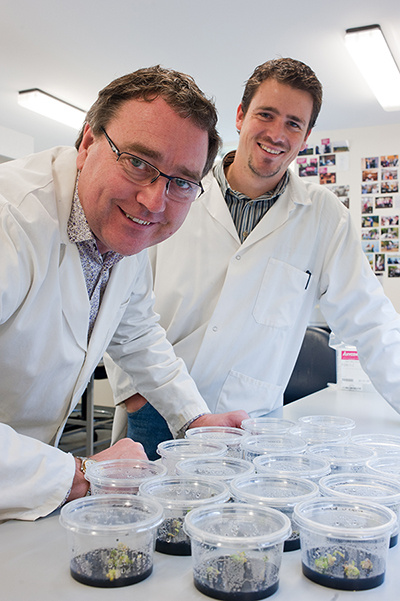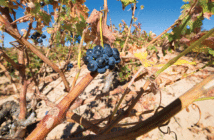Researchers at Lincoln University and Plant & Food Research are talking of a possible ‘revolution’ in the wake of genetic research which suggests ways to better productivity and disease resistance, along with the possibility of new grape varieties.
Dr Chris Winefield, project team leader and senior lecturer in Plant Molecular Biology at Lincoln University says a five-year project with Plant & Food Research initially aimed to bed down a research framework to establish a knowledge base for the study of gene behaviour and the critical processes of grape production. As time went on, new opportunities appeared and the team put more work into investigating the potential for manufacturing and encouraging the expression of genetic elements within grapevines. Dr Winefield says this could unlock commercial benefits.
At the heart of the research are transposons, described as naturally occurring, mobile DNA sequences that have the ability to replicate and insert themselves into new positions within the same or another chromosome.
Dr Winefield says all living organisms have transposons and often in very high quantities. Up to 40 per cent of the grape genome is made up of transposons with most inter-clonal diversity within grapevines caused by them. But while most transposon expression within a grape variety is unwelcome or harmful, they usually remain ‘silenced’ through the plant’s own internal system which looks to prevent new mutations.
The team says there are numerous cases, however, where transposons can be activated under certain stress conditions such as UV exposure, temperature shocks, or exposure to certain micro-organisms like bacteria or fungi. As such, the researchers explored how to activate and identify transposon expression within grapevines with a view to producing a population of plants in which each plant contained a number of new insertions.
“Through our five year project with Plant & Food Research we have now proven this to be possible and are looking to extend this work to produce populations of grapevines in which every gene in the genome contains a transposon insertion,” says Dr Winefield.
“In a sense we’re looking to create stress conditions so as to ‘hyper-activate’ the genome, thereby creating conditions conducive for dense, multiple transposon insertions,” says Dr Winefield. “We can then search the individual plants for transposon insertions in their genes and subsequently assess to what extent the transposon has disrupted the gene and what impact this will have on the plant.
“From there, we can assess which plants we could be interested in from a commercial perspective; for instance, for reasons such as disease tolerance, sustainable production, or a capacity to produce an interesting new variety of wine.”
To activate transposons, the researchers worked with plant tissue cultures from grapevines. After subjecting these cultures to a range of stress treatments, the plants were regenerated from the cultures and new transposons insertions, identified using bioinformatics. The work of Lincoln University PhD candidate Darrell Lizamore has been singled out as crucial in developing a way to identify and measure these genetic mutations – work which earned him the prestigious David Jackson prize last year, awarded for significant research showing potential for beneficial changes to the wine industry. A portion of his work was funded through a one-year Rob Bonfiglioli fellowship, with the backing of NZ Wine.
The problem of finding a method for identifying new transposon insertions, the research team said, was made all the more difficult by the large ‘background’ of ancient transposons in the grapevine genome, and the fact that new transposon insertions might only make up 0.2 per cent of the entire transposon complement.
To overcome this, transposons were ‘tagged’ using a fluorescent dye, after which the tagged DNA was sorted using a capillary DNA sequencer. This allowed transposons to be grouped according to their particular type and position within the grapevine’s DNA.
The systematic, multi-experimentation approach to overcome the problem of transposon identification, as well as other problems, such as the development of treatment protocols capable of activating specific transposons, has meant a considerable body of information is now available to the wine industry. This information is of particular importance as it involves sequencing approaches across the entire grape genome.
Now that the ‘hard yards’ are done, the researchers say, this sequencing and re-sequencing information is openly available to researchers who wish to identify individual plants with interesting new mutations, with an eye for replicating them further. Re-sequencing is a process whereby the complete set of genes making up a genome are catalogued and usually compared to the sequence (or catalogue) of genes from an original reference genome.
“The upshot of this work is that we are now in a position to encourage, identify and replicate mobile genetic elements so as to increase genetic diversity in grapevines,” says Dr Winefield. “This approach is non-GE and uses the same processes that underpin the formation of common bud-sports in grapes and other similar species.
“As far as the wine industry itself is concerned, we now have the means to generate new clones of existing varietals and the experimental framework to explore the production of completely new wines. This is very exciting and significant.”
The possibility of New Zealand leading the world in the production of completely new varieties has exciting commercial implications for a competitive industry where differentiation is important and where grape types are used to market products as a marker of style and quality.
The ground-breaking research also stands to contribute significantly to the international research community by having established a robust experimental research platform and database for other researchers to build on and leverage off for their own projects. Also, the research methodology and technology employed has considerable implications for other plant species important to New Zealand’s primary industries.
































































































